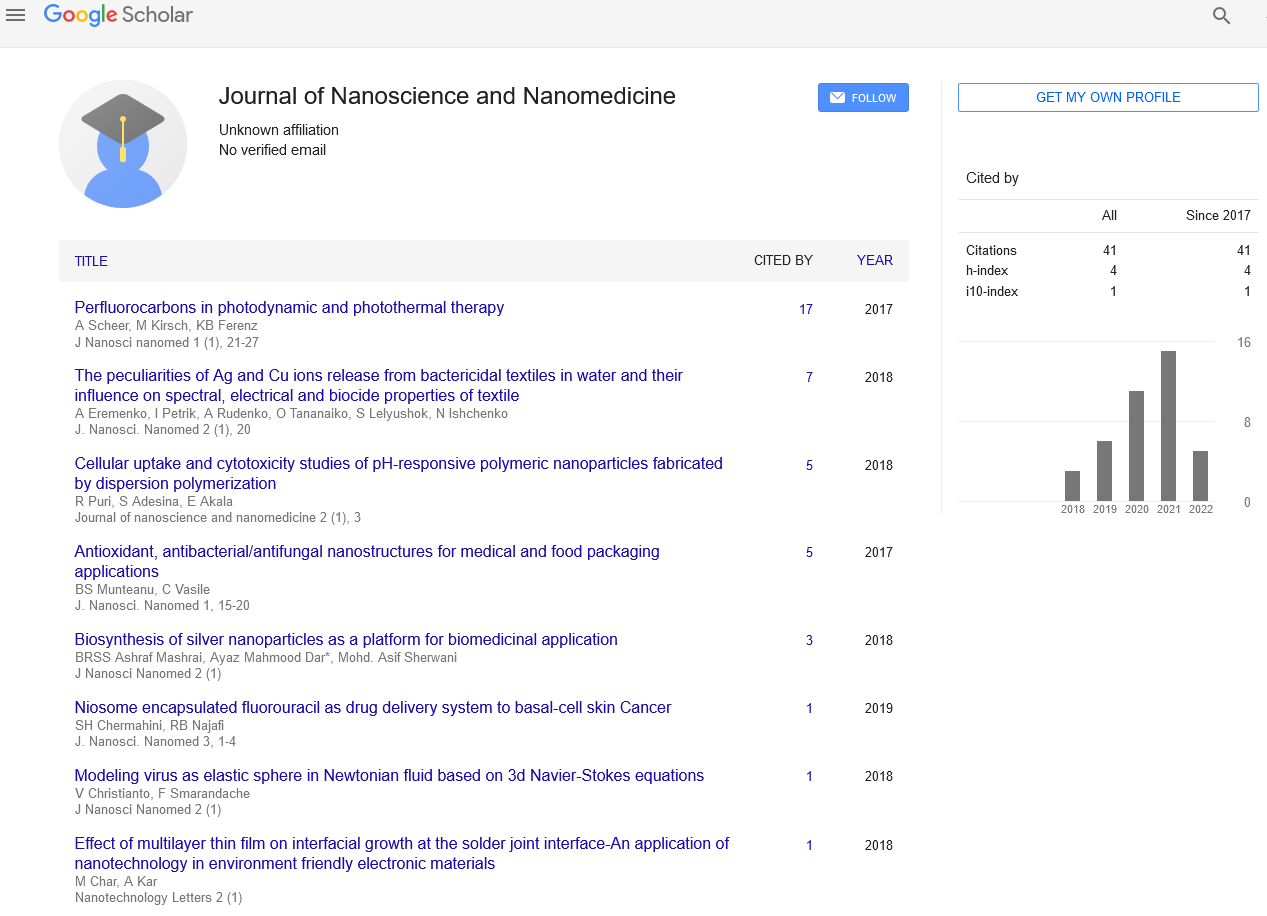An active goals of nanoelectronics-based sensors
Received: 01-Sep-2021 Accepted Date: Sep 15, 2021; Published: 22-Sep-2021
Citation: Remi F. An active goals of nanoelectronics-based sensors. J Nanosci Nanomed 2021;5(5):1-2.
This open-access article is distributed under the terms of the Creative Commons Attribution Non-Commercial License (CC BY-NC) (http://creativecommons.org/licenses/by-nc/4.0/), which permits reuse, distribution and reproduction of the article, provided that the original work is properly cited and the reuse is restricted to noncommercial purposes. For commercial reuse, contact reprints@pulsus.com
Abstract
Biosensing is among the foremost misused range of cutting-edge science. Distinctive sorts of natural frameworks counting proteins, antibodies, or ligand atoms have been utilized to distinguish a assortment of organic or chemical components like metabolites, poisons, pathogens, nourishment contaminants, poisonous components, etc. Utilizing these standards, a wide extend of biosensors has been concocted and commercialized. Presently the later advancement in nanotechnology and its headway opens up a modern opportunity within the field of biosensors. Distinctive nanoparticles, nanotubes, nanowires, and nanorods give a assortment of supportive properties viz. tall surface-area-to-volume proportion, superior conductivity, more delicate reaction, and more flexible location component based on color. Separated from these, the presentation of nanotechnology in biosensors decreases it’s taken a toll and measure and gives ultralow limits of discovery. Strength and reproducibility is another moved forward character of nanobiosensors. A nanobiosensor has been effectively executed within the healthcare and natural observing as well as pathogenic microbes discovery and field of agriculture. In this chapter we are going discuss about distinctive nanotechnology-based biosensors, their developments, standards, and utilize completely different viewpoints of human and natural welfare.
Keywords
Biosensing; Nanotechnology; Nano-electronics; Nanobiosensor
Introduction
Biosensors comprise of bioreceptors combined with a transducer and an electronic framework along with a show for discovery of an analyte. These analytes incorporate expansive number of biomolecules, disease markers, melamine in nourishments, etc. Advancement within the field of nanotechnology serves as a blessing in the advancement of biosensors. Biosensors have picked up their significance with their special properties of selectivity, solidness, affectability, linearity, reproducibility. Biosensorbased inquire about is multidisciplinary which includes different standards from distinctive sciences like nanotechnology, electronics, medical sciences, nourishment handling, etc [1].
Nanomaterials are the materials having at slightest one or more measurements in nanoscale, i.e., in the range of 1e100 nm. At such a scale, materials have fabulous alluring properties, such as electronic conductivity, tall surface-area-to-volume proportion, attractive, huge surface zone, and other physical and optical properties. Differing shapes of nanomaterials such as nanorods, nanotubes, nanoparticles, nanowires, nanocrystals, nanopores, and numerous others have been effectively connected to develop numerous biosensors which can be utilized to extend their affectability, accuracy, and effectiveness. A few of them utilized in biosensor applications are carbon nanotubes, silver nanoparticles, platinum electrodes, gold nanoparticles, graphene, silicon dioxide, nickel terminals, cellulose nanofiberebased nanocapsules, etc [2].
From the past a few a long time, where nanotechnology has been broadly considered, tremendous number of nanomaterials have been found, designed, and synthesized totally different shapes and for various purposes. Nearly all the metals, specifically, gold, silver, platinum, press, manganese, titanium, copper, aluminum, zinc, zirconium, cobalt, nickel, tungsten, and vanadium, are utilized to synthesize nanoparticles from considering their interesting properties for a wide run of application. There are some nonmetals and metalloids like carbon, silicon, boron, and phosphorous which are moreover included in synthesis of nanomaterials either absolutely or by shaping composites with metals. Separated from metals and nonmetals another lesson of materials called biopolymers have too been utilized for the improvement of several nanobiosensors. They are utilized for the most part for surface coating and modification. Although most of the nanoparticles are utilized completely different biosensors, as it were a few of them are examined in detail here [3].
Properties of nanomaterials utilized for discovery in biosensors The nanomaterial-based location concerned, most of the location instrument employments tall surface-areato-volume proportion, fluorescent, attractive, tall affectability dielectric properties of the nanomaterials. Detection of few biomolecules by metal nanoparticles is based on the LSPR property where the discovery method depends on the tall affectability and the attractive property of metal nanoparticles. At the side LSPR-based procedures, metal nanoparticles are utilized in DNA sequence change location where the AuNP streams are transmitted into a natural environment until they reach the recipient, where the detecting stage is made of silica and AuNPs. This captures the DNA grouping and uncovers any changes show within the grouping when compared with a few colloidal particles [4].
Conclusion
Nanotechnology being the foremost rising and exceedingly inquired about science is utilized to potentially develop biosensors in different applications such as environment, nourishment handling, and particularly medication where the part of sensors is radically expanding with the revelation of unused infections. There are biosensors for the same fabricated in conventional ways but have few accumulations like sensitivity and selectivity. These downsides can be possibly overcome by the biosensors where the transducer system is based on nanomaterials. This chapter cantered on the later improvements within the nanotechnology to be accessible to form biosensors to distinguish biomolecules, including glucose, DNA, protein, poisons, etc. Ponder within the field of nanomaterial-based biosensors might be intrigue as the discovery instruments include electrical, mechanical, optical, electrochemical, and immunoassay techniques. Another critical advantage of nanomaterial is their secure utilization and as it were less harmful at consumption in higher quantities.
REFERENCES
- Alpat SO, Alpat S. Voltammetric determination of epinephrine in pharmaceutical sample with a tyrosinase nanobiosensor. J Sensors. 2016;9.
- Bellan LM, Wu D, Langer RS. Current trends in nanobiosensor technology. Wiley Interdisciplinary Reviews. Nanomed Nanobiotech. 2017;3(3):229e246.
- Boisselier E, Astruc D. Gold nanoparticles in nanomedicine: preparations, imaging, diagnostics, therapies and toxicity. Chem society rev. 2009;38(6):1759e1782.
- Ramamoorthy R, Kanagasabai V, Kausalya R. Impact of celebrities’ image on brand. Int J Pure Appl Math. 2018;119(12):3625-3630.





